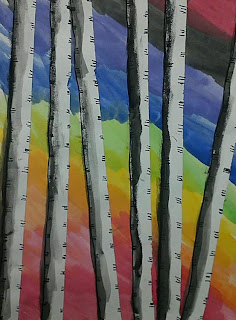2 Class Periods
 |
| Birch Tree Landscape, Fourth Grade Art Lesson |
- As a class we reviewed the four parts of a landscape: foreground, middle ground, background, and horizon line.
- We discussed how our paintings were going to concentrate on the middle ground aspect of a landscape. Our trees would have no tops or bottoms (zoomed in view).
- Using watercolor paper we placed painters tape on the paper to create the trees for the composition. Students were asked to have at least 5 trees in their composition. The trees could overlap, but they had to go off the page from top to bottom.
 |
| Student taping trees in place. |
- As a class we discussed analogous color schemes (colors next to each other on the color wheel). Students were reminded that colors had better blending transitions if they were closer together on the wheel versus further apart.
- A wet-in-wet technique was demonstrated to the class.
- After painting, students slowly removed the tape revealing the resist which created the Birch tree.
- On the second day we discussed the concept of light and shadow. Students were asked to pick a light source and decide where it would be coming from within the composition.
- A demonstration was given on how to shade the side furthest from the light source with black tempera paint. Students used a wet brush to soften the edge of the black paint to create a gray tone. The value scale (light to dark) that was created gives the illusion of a three-dimensional tree within the composition.
- Students completed the project by adding the short horizontal lines within each tree to define it as a Birch tree.
Student painting shadows on trees.
Student Examples:
































































